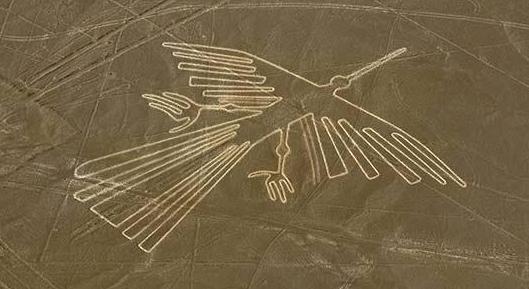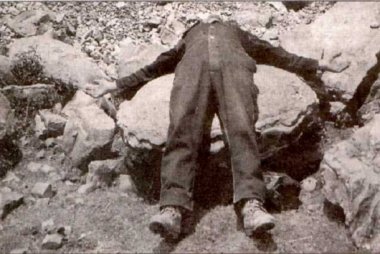So in 15th century Spaniards found white lines drew on ground in Peru on the desert. Some of these lanes run straight for kilometers (up to 40), some create geometric figures and some form 70 images of animals, plants and humans. The images reach 360 meters in length. Back in 15th century Spanish people didn't see anything special about them, unless they looked from a hill. Authors of these drawings are native people from Nazca city, who probably made them about 2000 years ago. They removed rocks and earth to create something like a negative image so that the area without ground and rock is forming what we see in Nazca today. Location of the drawings is vital for their preservation, because Nazca Desert is the driest place on Earth. The wind doesn't blow much there, either. Purpose of so called Nazca Lines remains uncertain. Only after the plane was invented, people could fully admire their beauty and complexity. Every figure is impressive, but the spider is the most interesting and I will reveal why, in the next post.
niedziela, 29 października 2017
Nazca Lines
In my third post about archaeology and interesting discoveries from around the world, I would like to write about ancient geoglyphs in South America. These belong to UNESCO World Heritage Site since 1994.
sobota, 21 października 2017
Petrified clams
My topic for this semester will be archaeology. I will be writing about interesting stuff, that was found all over the world.
In 1953 a few men were climbing Mount Everest. When they reached the top they found many petrified clams. Also in Peru, in 1990', giant fossilized clams were found 3 kilometers above sea level (see picture) . What is more, they were in closed position in both cases. Clam is a marine creature, that spend most of its time partially buried in sand on the bottom of the ocean. When it dies, muscles relax and clam opens up almost immediately. There can be only one conclusion-they must have been buried alive.I daresay, there is no other possibility than catastrophy, that occurred in past. I think worldwide flood is the best explonation for this phenomenon, because flood could bury those clams in mud, where they would fossilize. It may also explain how did they get on the mountains.
In 1953 a few men were climbing Mount Everest. When they reached the top they found many petrified clams. Also in Peru, in 1990', giant fossilized clams were found 3 kilometers above sea level (see picture) . What is more, they were in closed position in both cases. Clam is a marine creature, that spend most of its time partially buried in sand on the bottom of the ocean. When it dies, muscles relax and clam opens up almost immediately. There can be only one conclusion-they must have been buried alive.I daresay, there is no other possibility than catastrophy, that occurred in past. I think worldwide flood is the best explonation for this phenomenon, because flood could bury those clams in mud, where they would fossilize. It may also explain how did they get on the mountains.
poniedziałek, 16 października 2017
Topic; Dinosaur bone with soft tissue
My topic for this semester will be archaeology. I will be writing about interesting stuff, that was found all over the world.
In 2005 Mary Schweitzer and her crew dug up a dinosaur bone in Montana in USA. It wouldn't be anything new, if the bone didn't have soft tissue inside. Soft tissue is the first to decay after human or animal dies. Of course the bone was not filled up with blood or medulla. Mary saw something that looked like red cells in it. After studying it with microscope (see picture), Mary could happily announce her colleagues that she found a bone with soft tissue inside. As dinosaurs are believed to lived millions of years ago, it was astonishing discovery. Soft tissue can't survive that much time in normal conditions. Mary led long studies on how it could happen. It could be predicted, that they failed. Some people say iron from animal body could preserve blood cells. On the second hand, this discovery perfectly fits young Earth creationists point of view. Unfortunately, we will probably never know the truth behind this controversial discovery.
In 2005 Mary Schweitzer and her crew dug up a dinosaur bone in Montana in USA. It wouldn't be anything new, if the bone didn't have soft tissue inside. Soft tissue is the first to decay after human or animal dies. Of course the bone was not filled up with blood or medulla. Mary saw something that looked like red cells in it. After studying it with microscope (see picture), Mary could happily announce her colleagues that she found a bone with soft tissue inside. As dinosaurs are believed to lived millions of years ago, it was astonishing discovery. Soft tissue can't survive that much time in normal conditions. Mary led long studies on how it could happen. It could be predicted, that they failed. Some people say iron from animal body could preserve blood cells. On the second hand, this discovery perfectly fits young Earth creationists point of view. Unfortunately, we will probably never know the truth behind this controversial discovery.
poniedziałek, 9 października 2017
First thing I found disturbing in video titled "Jay Walker- English mania" is fact, that it is obligatory to study English, starting from third grade, in China. As a result China will (or has already) become the largest english-speaking country in the world. Third thing, that drew my attention, is enormous number of people learning English now. 2 billion people struggling to master the same language is pretty impressive.
Subskrybuj:
Komentarze (Atom)



